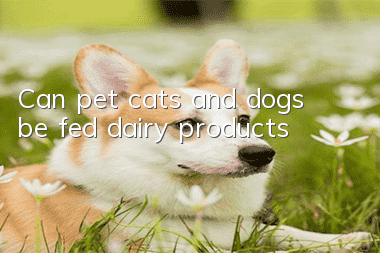Can pet cats and dogs be fed dairy products?

Many pet owners also have questions about whether they can feed "cheese", yogurt and other dairy products to dogs and cats after learning that they cannot feed milk to their pets. So can you feed "cheese" to pet dogs and cats?
There are many types of "cheese". First, let's talk about the concept. What we call "cheese" here refers to "cheese". "Cheese" is a fermented milk product whose properties are similar to common milk. , are made through a fermentation process and are rich in lactic acid bacteria, but the concentration of cheese is higher than that of yogurt, which is similar to solid food, and its nutritional value is therefore richer. Each kilogram of cheese products is concentrated from 10 kilograms of milk. It is rich in nutrients such as protein, calcium, fat, phosphorus and vitamins. It is a purely natural food. In terms of technology, cheese is fermented milk; in terms of nutrition, cheese is concentrated milk.
1. "Cheese" ≠ "Milk"
The reason why we do not recommend feeding milk to dogs and cats is mainly because milk contains high lactose content, which can easily lead to lactose intolerance in some pet dogs and cats. In terms of its nutritional value, milk is relatively rich in nutrients. Taste. But cheese is different. Cheese contains (calculated based on 100 grams of edible part) 25.7% protein, 23.5% fat, 3.5% carbohydrates, and is also rich in calcium 799mg, phosphorus 326mg, etc. The most important thing is that in cheese production, Most of the lactose is excreted with the whey, and the rest is turned into lactic acid through fermentation. Therefore, the lactose content in cheese is generally 0.5%~0.8%, which is lower than the 4.5%~4.8% lactose content in fresh cow milk. According to statistics, lactose intolerance caused by milk is common in dogs and cats, but lactose intolerance caused by cheese is rare.
2.The reasons why it is not recommended to feed milk to pets are as follows:
1. Simply feeding milk can cause arginine deficiency in pets
According to the 1981 Vainisi animal experiment report, puppies that were fed milk for 7 to 10 days completely replaced the diet. Cataracts appeared in the puppies after 3 weeks of feeding. This cataract can be prevented by supplementing arginine, or byOther lactating bitches nurse puppies to prevent it. The experiment concluded that feeding milk entirely as a substitute for pet diets will produce cataracts, and the cataracts are caused by the lack of arginine in feeding milk.
2. Feeding milk is prone to lactose intolerance
Among the disaccharides, there is a lot of discussion about lactose, especially regarding the lactose content in milk and whether it is recommended for pets to eat milk. Lactose is a disaccharide present in milk, mainly free lactose. Depending on the mammalian source, the lactose content in milk varies greatly, generally between 2% and 8.5%. The lactose content in dog milk is 3%, the lactose content in cow's milk and goat's milk is 4.5%~4.8% (from the perspective of lactose, goat's milk has no lower lactose than cow's milk), and the lactose content in human milk is 7%. Pet dogs and cats Lactase is present in the small intestine and has a certain activity, but it decreases rapidly with age. Therefore, pet dogs and cats who consume milk will have varying degrees of lactose intolerance (but there are also cases where some dogs and cats are fine if they drink milk. ). Lactose intolerance is because the lactose ingested by pets cannot be hydrolyzed at all or only a small part is hydrolyzed. Due to the lack of lactase or low lactase activity, dogs can only digest limited lactose.
Cats are in the same situation. There is no lactase in cat pancreatic tissue (there is also a saying that there is a small amount and extremely low activity). Although there are two lactase enzymes in the intestinal mucosa, it is very likely that they are acid hydrolases that do not participate in the digestion of lactose. Lactose exists in the intestinal lumen. After undecomposed and absorbed lactose enters the colon, it is fermented by bacteria present in the intestine into small-molecule organic acids, such as acetic acid, propionic acid, butyric acid, etc., and produces some gases such as methane, H2, and CO2. Etc., undecomposed lactose can cause symptoms such as bowel sounds, bloating, abdominal pain, flatulence, discomfort, diarrhea and other symptoms. At the same time, lactose has a tendency to cause liquid to flow into the intestinal cavity due to osmotic pressure. This phenomenon aggravates abdominal distension and Spasms. Therefore, after pets drink milk, they will suffer from diarrhea, bloating and even vomiting because they cannot fully digest and absorb lactose.
In addition, the acidic products of intestinal fermentation in dogs and cats further reduce the acidic pH, constantly irritating the large intestinal mucosa, and eventually causing diarrhea in pets.
Based on the above analysis, we know that "cheese cheese" and yogurt can be fed to pets. Now "pet cheese" foods professionally designed for pets have emerged on the market. They are basically made of cheese, dairy products, and salt. Composed of several ingredients including lactobacilli and lactic acid bacteria, this type of "cheese" food designed for pets also has very low lactose content, generally less than 1%. Therefore, we concluded that as long as it has low lactose content (<1%) Cheese food can be fed to pets, and yogurt can also be fed to dogs and cats, but the high lactose contentMilk is not recommended for dogs and cats.
- Summer is coming, signs and prevention methods of heatstroke in pets
- How much does a Boxer dog cost and is it easy to raise_Common diseases|Pictures
- What to do if your Greater Swiss Mountain Dog is anemic?
- How much do you know about the late symptoms of canine distemper and parvovirus?
- Causes of ascites in dogs
- Why you should bathe your dog regularly
- What's wrong with dogs snoring while sleeping?
- What's the matter with dogs digging into their nests?
- How to train a dog to play with a ball? Successful training in just a few steps!
- How to train a small Xiasi hound to be obedient? Training tips for Xiasi hounds!



